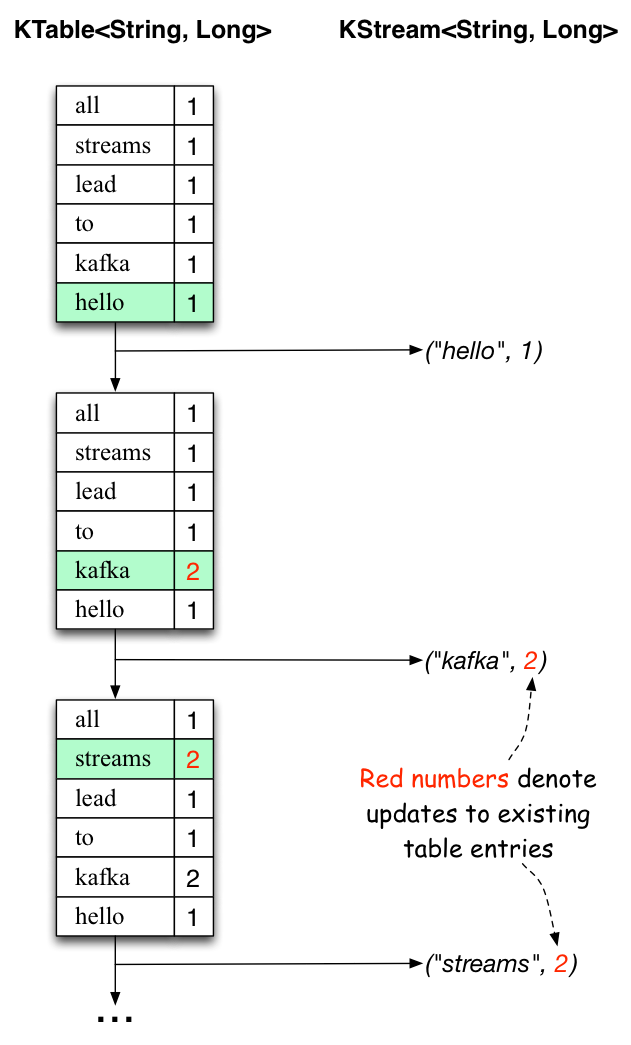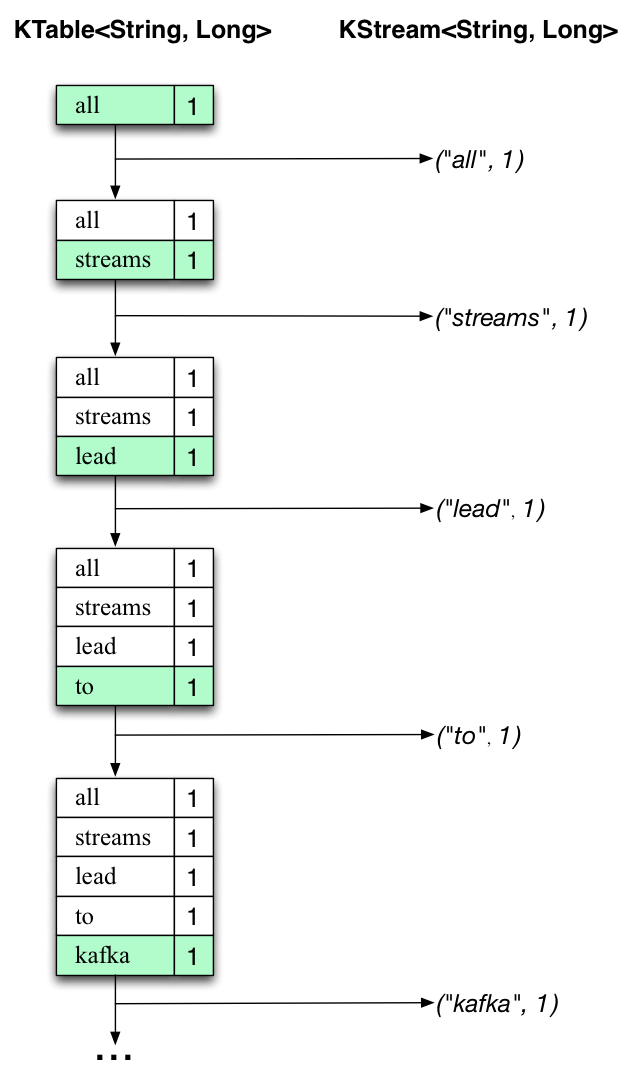Run Kafka Streams Demo Application
This tutorial assumes you are starting fresh and have no existing Kafka or ZooKeeper data. However, if you have already started Kafka, feel free to skip the first two steps.
Kafka Streams is a client library for building mission-critical real-time applications and microservices, where the input and/or output data is stored in Kafka clusters. Kafka Streams combines the simplicity of writing and deploying standard Java and Scala applications on the client side with the benefits of Kafka's server-side cluster technology to make these applications highly scalable, elastic, fault-tolerant, distributed, and much more.
This quickstart example will demonstrate how to run a streaming application coded in this library. Here is the gist
of the WordCountDemo example code (converted to use Java 8 lambda expressions for easy reading).
// Serializers/deserializers (serde) for String and Long types
final Serde<String> stringSerde = Serdes.String();
final Serde<Long> longSerde = Serdes.Long();
// Construct a `KStream` from the input topic "streams-plaintext-input", where message values
// represent lines of text (for the sake of this example, we ignore whatever may be stored
// in the message keys).
KStream<String, String> textLines = builder.stream(
"streams-plaintext-input",
Consumed.with(stringSerde, stringSerde)
);
KTable<String, Long> wordCounts = textLines
// Split each text line, by whitespace, into words.
.flatMapValues(value -> Arrays.asList(value.toLowerCase().split("\\W+")))
// Group the text words as message keys
.groupBy((key, value) -> value)
// Count the occurrences of each word (message key).
.count();
// Store the running counts as a changelog stream to the output topic.
wordCounts.toStream().to("streams-wordcount-output", Produced.with(Serdes.String(), Serdes.Long()));It implements the WordCount algorithm, which computes a word occurrence histogram from the input text. However, unlike other WordCount examples you might have seen before that operate on bounded data, the WordCount demo application behaves slightly differently because it is designed to operate on an infinite, unbounded stream of data. Similar to the bounded variant, it is a stateful algorithm that tracks and updates the counts of words. However, since it must assume potentially unbounded input data, it will periodically output its current state and results while continuing to process more data because it cannot know when it has processed "all" the input data.
As the first step, we will start Kafka (unless you already have it started) and then we will prepare input data to a Kafka topic, which will subsequently be processed by a Kafka Streams application.
Step 1: Download the code
Download the {{fullDotVersion}} release and un-tar it. Note that there are multiple downloadable Scala versions and we choose to use the recommended version ({{scalaVersion}}) here:$ tar -xzf kafka_{{scalaVersion}}-{{fullDotVersion}}.tgz
$ cd kafka_{{scalaVersion}}-{{fullDotVersion}}Step 2: Start the Kafka server
Apache Kafka can be started using ZooKeeper or KRaft. To get started with either configuration follow one of the sections below but not both.
Kafka with ZooKeeper
Run the following commands in order to start all services in the correct order:
$ bin/zookeeper-server-start.sh config/zookeeper.propertiesOpen another terminal session and run:
$ bin/kafka-server-start.sh config/server.propertiesKafka with KRaft
Generate a Cluster UUID
$ KAFKA_CLUSTER_ID="$(bin/kafka-storage.sh random-uuid)"Format Log Directories
$ bin/kafka-storage.sh format -t $KAFKA_CLUSTER_ID -c config/kraft/server.propertiesStart the Kafka Server
$ bin/kafka-server-start.sh config/kraft/server.propertiesStep 3: Prepare input topic and start Kafka producer
Next, we create the input topic named streams-plaintext-input and the output topic named streams-wordcount-output:$ bin/kafka-topics.sh --create \
--bootstrap-server localhost:9092 \
--replication-factor 1 \
--partitions 1 \
--topic streams-plaintext-input
Created topic "streams-plaintext-input".$ bin/kafka-topics.sh --create \
--bootstrap-server localhost:9092 \
--replication-factor 1 \
--partitions 1 \
--topic streams-wordcount-output \
--config cleanup.policy=compact
Created topic "streams-wordcount-output".$ bin/kafka-topics.sh --bootstrap-server localhost:9092 --describe
Topic:streams-wordcount-output PartitionCount:1 ReplicationFactor:1 Configs:cleanup.policy=compact,segment.bytes=1073741824
Topic: streams-wordcount-output Partition: 0 Leader: 0 Replicas: 0 Isr: 0
Topic:streams-plaintext-input PartitionCount:1 ReplicationFactor:1 Configs:segment.bytes=1073741824
Topic: streams-plaintext-input Partition: 0 Leader: 0 Replicas: 0 Isr: 0Step 4: Start the Wordcount Application
The following command starts the WordCount demo application:$ bin/kafka-run-class.sh org.apache.kafka.streams.examples.wordcount.WordCountDemoThe demo application will read from the input topic streams-plaintext-input, perform the computations of the WordCount algorithm on each of the read messages, and continuously write its current results to the output topic streams-wordcount-output. Hence there won't be any STDOUT output except log entries as the results are written back into in Kafka.
Now we can start the console producer in a separate terminal to write some input data to this topic:$ bin/kafka-console-producer.sh --bootstrap-server localhost:9092 --topic streams-plaintext-input$ bin/kafka-console-consumer.sh --bootstrap-server localhost:9092 \
--topic streams-wordcount-output \
--from-beginning \
--property print.key=true \
--property print.value=true \
--property key.deserializer=org.apache.kafka.common.serialization.StringDeserializer \
--property value.deserializer=org.apache.kafka.common.serialization.LongDeserializerStep 5: Process some data
Now let's write some message with the console producer into the input topic streams-plaintext-input by entering a single line of text and then hit <RETURN>. This will send a new message to the input topic, where the message key is null and the message value is the string encoded text line that you just entered (in practice, input data for applications will typically be streaming continuously into Kafka, rather than being manually entered as we do in this quickstart):$ bin/kafka-console-producer.sh --bootstrap-server localhost:9092 --topic streams-plaintext-input
>all streams lead to kafkaThis message will be processed by the Wordcount application and the following output data will be written to the streams-wordcount-output topic and printed by the console consumer:
$ bin/kafka-console-consumer.sh --bootstrap-server localhost:9092 \
--topic streams-wordcount-output \
--from-beginning \
--property print.key=true \
--property print.value=true \
--property key.deserializer=org.apache.kafka.common.serialization.StringDeserializer \
--property value.deserializer=org.apache.kafka.common.serialization.LongDeserializer
all 1
streams 1
lead 1
to 1
kafka 1
Here, the first column is the Kafka message key in java.lang.String format and represents a word that is being counted, and the second column is the message value in java.lang.Longformat, representing the word's latest count.
$ bin/kafka-console-producer.sh --bootstrap-server localhost:9092 --topic streams-plaintext-input
>all streams lead to kafka
>hello kafka streams$ bin/kafka-console-consumer.sh --bootstrap-server localhost:9092 \
--topic streams-wordcount-output \
--from-beginning \
--property print.key=true \
--property print.value=true \
--property key.deserializer=org.apache.kafka.common.serialization.StringDeserializer \
--property value.deserializer=org.apache.kafka.common.serialization.LongDeserializer
all 1
streams 1
lead 1
to 1
kafka 1
hello 1
kafka 2
streams 2$ bin/kafka-console-producer.sh --bootstrap-server localhost:9092 --topic streams-plaintext-input
>all streams lead to kafka
>hello kafka streams
>join kafka summit$ bin/kafka-console-consumer.sh --bootstrap-server localhost:9092 \
--topic streams-wordcount-output \
--from-beginning \
--property print.key=true \
--property print.value=true \
--property key.deserializer=org.apache.kafka.common.serialization.StringDeserializer \
--property value.deserializer=org.apache.kafka.common.serialization.LongDeserializer
all 1
streams 1
lead 1
to 1
kafka 1
hello 1
kafka 2
streams 2
join 1
kafka 3
summit 1
The two diagrams below illustrate what is essentially happening behind the scenes.
The first column shows the evolution of the current state of the KTable<String, Long> that is counting word occurrences for count.
The second column shows the change records that result from state updates to the KTable and that are being sent to the output Kafka topic streams-wordcount-output.


First the text line "all streams lead to kafka" is being processed.
The KTable is being built up as each new word results in a new table entry (highlighted with a green background), and a corresponding change record is sent to the downstream KStream.
When the second text line "hello kafka streams" is processed, we observe, for the first time, that existing entries in the KTable are being updated (here: for the words "kafka" and for "streams"). And again, change records are being sent to the output topic.
And so on (we skip the illustration of how the third line is being processed). This explains why the output topic has the contents we showed above, because it contains the full record of changes.
Looking beyond the scope of this concrete example, what Kafka Streams is doing here is to leverage the duality between a table and a changelog stream (here: table = the KTable, changelog stream = the downstream KStream): you can publish every change of the table to a stream, and if you consume the entire changelog stream from beginning to end, you can reconstruct the contents of the table.
Step 6: Teardown the application
You can now stop the console consumer, the console producer, the Wordcount application, the Kafka broker and the ZooKeeper server (if one was started) in order via Ctrl-C.